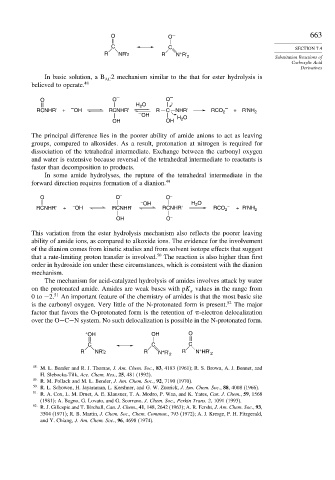Page 681 - Advanced Organic Chemistry Part A - Structure and Mechanisms, 5th ed (2007) - Carey _ Sundberg
P. 681
O O – 663
C C SECTION 7.4
R NR'2 R N R' 2 Substitution Reactions of
+
Carboxylic Acid
Derivatives
In basic solution, a B 2 mechanism similar to the that for ester hydrolysis is
AC
believed to operate. 48
O O – O –
H O
2
RCNHR' + – OH RCNHR' R C NHR' RCO – + R'NH
– 2 2
OH O
OH OH H 2
The principal difference lies in the poorer ability of amide anions to act as leaving
groups, compared to alkoxides. As a result, protonation at nitrogen is required for
dissociation of the tetrahedral intermediate. Exchange between the carbonyl oxygen
and water is extensive because reversal of the tetrahedral intermediate to reactants is
faster than decomposition to products.
In some amide hydrolyses, the rupture of the tetrahedral intermediate in the
forward direction requires formation of a dianion. 49
O O – O –
– OH H O
RCNHR' + – OH RCNHR' RCNHR' 2 RCO 2 – + R'NH 2
OH O –
This variation from the ester hydrolysis mechanism also reflects the poorer leaving
ability of amide ions, as compared to alkoxide ions. The evidence for the involvement
of the dianion comes from kinetic studies and from solvent isotope effects that suggest
that a rate-limiting proton transfer is involved. 50 The reaction is also higher than first
order in hydroxide ion under these circumstances, which is consistent with the dianion
mechanism.
The mechanism for acid-catalyzed hydrolysis of amides involves attack by water
on the protonated amide. Amides are weak bases with pK values in the range from
a
0to −2. 51 An important feature of the chemistry of amides is that the most basic site
is the carbonyl oxygen. Very little of the N-protonated form is present. 52 The major
factor that favors the O-protonated form is the retention of -electron delocalization
over the O−C−N system. No such delocalization is possible in the N-protonated form.
+ OH OH O
C C C
+
+
R NR'2 R N R' 2 R N HR' 2
48 M. L. Bender and R. J. Thomas, J. Am. Chem. Soc., 83, 4183 (1961); R. S. Brown, A. J. Bennet, and
H. Slebocka-Tilk, Acc. Chem. Res., 25, 481 (1992).
49
R. M. Pollack and M. L. Bender, J. Am. Chem. Soc., 92, 7190 (1970).
50 R. L. Schowen, H. Jayaraman, L. Kershner, and G. W. Zuorick, J. Am. Chem. Soc., 88, 4008 (1966).
51 R. A. Cox, L. M. Druet, A. E. Klausner, T. A. Modro, P. Wan, and K. Yates, Can. J. Chem., 59, 1568
(1981); A. Bagno, G. Lovato, and G. Scorrano, J. Chem. Soc., Perkin Trans. 2, 1091 (1993).
52
R. J. Gillespie and T. Birchall, Can. J. Chem., 41, 148, 2642 (1963); A. R. Fersht, J. Am. Chem. Soc., 93,
3504 (1971); R. B. Martin, J. Chem. Soc., Chem. Commun., 793 (1972); A. J. Kresge, P. H. Fitzgerald,
and Y. Chiang, J. Am. Chem. Soc., 96, 4698 (1974).

